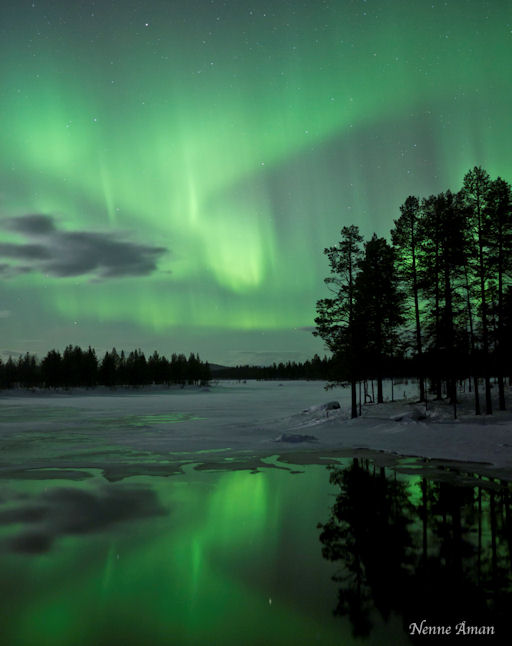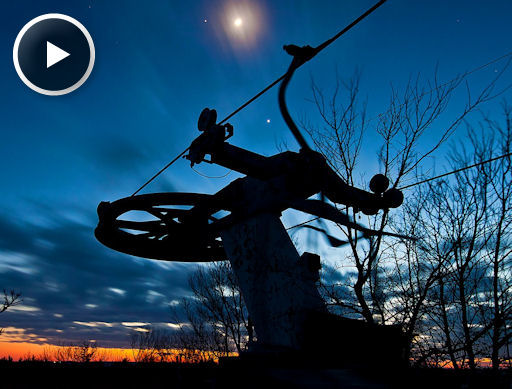MARS AT OPPOSITION: Mars is approaching opposition. On March 3-5, the Red Planet will be up all night long, opposite the sun and as close to Earth as it will get in 2012. Mars shines overhead at midnight 6 times brighter than a 1st magnitude star and looks great through a backyard telescope. [sky map] [photos: #0, #1, #2, #3, #4]
END OF FEBRUARY AURORAS: February is coming to an end with a flourish of auroras. A CME impact followed by a gusty solar wind stream have combined to produce bright lights around the Arctic Circle on Feb. 26-28. Photographer Nenne Åman recorded the scene last night in Revi, Sweden:
"The show was short but very beautiful!" says Åman.
Because 2012 is a leap year, February isn't finished yet. Arctic sky watchers should be alert tonight for some of the rarest auroras of all--those that occur on Feb. 29th. Aurora alerts: text, phone.
more images: from Andrei Penescu of Kangerlussuaq, Greenland; from Heikki Mastokangas of Finland, Lestijärvi; from Andy Keen of Inari Municipality, Lapland, Finland; from Jan Pawlowski of Jyvaeskylae, Finland; from Tom Eklund of Valkeakoski, Finland; from B.Art Braafhart of Salla, Finnish-Lapland; from Ole C. Salomonsen of Muonio, Finland; from Aleksander Chernucho of Kola peninsula, Russia, Mt. Khibiny; from Riku Valtasaari of Tampere, Finland; from Joni Niemelä of Western Finland
February 2012 Aurora Gallery
[previous Februaries: 2011, 2010, 2009, 2008, 2007, 2006, 2004, 2003, 2002]
AFTER-IMAGES: The planetary conjunction of Feb. 26-27 is over now, but photographers are still processing and submitting their images. For sky watchers who missed the show, here is one last round of images, beginning with a video from an abandoned ski run in northern Nebraska:
"The combination of planets with pale moon light, deep twilight colors, and the motion blur of clouds during a long exposure was enthralling," says photographer Chris Allington.
As the three-way meeting of Jupiter, Venus and the Moon breaks up, attention turns to the other side of the sky where Mars is approaching Earth for a close encounter on March 3-5. "Turn your back on the dazzling duo of Jupiter and Venus and you can see the third bright planet of the season rising in the east -- Mars!" says astronomy professor Jimmy Westlake of Stagecoach, Colorado. He took this picture of the red planet on Feb. 27th.

![]()
Solar wind
speed: 461.8 km/sec
density: 0.0 protons/cm3
explanation | more data
Updated: Today at 1614 UT
![]()
X-ray Solar Flares
6-hr max: B4 1525 UT Feb29
24-hr: B5 0738 UT Feb29
explanation | more data
Updated: Today at: 1600 UT
![]()
![]()
![]()
Daily Sun: 29 Feb 12
![]()
![]()
These sunspots pose no threat for strong flares. Credit: SDO/HMI
![]()
![]()
![]()
Sunspot number: 35
What is the sunspot number?
Updated 28 Feb 2012
Spotless Days
Current Stretch: 0 days
2012 total: 0 days (0%)
2011 total: 2 days (<1%)
2010 total: 51 days (14%)
2009 total: 260 days (71%)
Since 2004: 821 days
Typical Solar Min: 486 days
Updated 28 Feb 2012
The Radio Sun
10.7 cm flux: 103 sfu
explanation | more data
Updated 28 Feb 2012
![]()
![]()
![]()
Current Auroral Oval:
![]()
Switch to: Europe, USA, New Zealand, Antarctica
Credit: NOAA/POES
![]()
![]()
![]()
Planetary K-index
Now: Kp= 0 quiet
24-hr max: Kp= 2 quiet
explanation | more data
![]()
Interplanetary Mag. Field
Btotal: 7.7 nT
Bz: 0.6 nT north
explanation | more data
Updated: Today at 1616 UT
![]()
![]()
![]()
Coronal Holes: 29 Feb 12
![]()
![]()
A solar wind stream flowing from this minor coronal hole could reach Earth on March 4-5. Credit: SDO/AIA.






